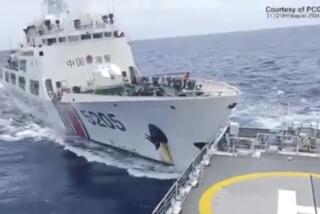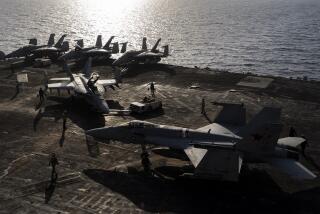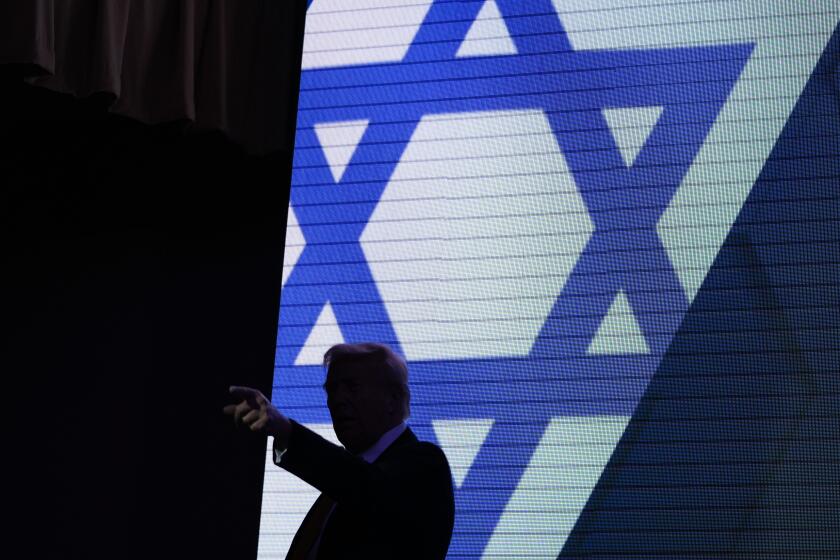U.S. Carrier Group Sails Near China as Tensions Over Taiwan Mount
WASHINGTON — The Pentagon acknowledged Friday that a U.S. aircraft carrier sailed through the Taiwan Strait last month, apparently the first time any such vessel has done so since the United States and China established diplomatic relations in 1979.
U.S. officials asserted that the Dec. 19 trip by the carrier Nimitz--accompanied by a U.S. Navy cruiser, a destroyer, a frigate and two support ships--was made only to avoid bad weather as the carrier group went from the West Coast of the United States to Hong Kong.
However, it amounted to an extraordinary show of U.S. naval power in the Taiwan Strait at a time when China has been conducting military exercises there and when some Chinese officials have been making threats about the possible use of force against Taiwan.
“These were international waters,” State Department spokesman Nicholas Burns said Friday. “America is a Pacific power. We are a great naval power. We have warships that pass through international waters all the time in all parts of the world.”
State Department and Pentagon officials maintained that the trip was routine. But several of them acknowledged that they could not recall any other time since 1979 when a U.S. aircraft carrier has gone through the Taiwan Strait.
U.S. Navy officials said only that two other, smaller U.S. warships passed through the strait last year, and one of these was on Dec. 11, barely a week in advance of the aircraft carrier.
“I think the message was loud and clear,” said Douglas Paal, who served as director of Asian affairs for the George Bush administration’s National Security Council. “There are Chinese exercises out there. This is a show of counter-muscle [by the United States]. We needed to show that we have some stake out there.”
Throughout the 1950s, there was military tension in the Taiwan Strait as Chiang Kai-shek’s Nationalist regime regularly talked of regaining mainland China and Mao Tse-tung’s Communist regime in Beijing threatened to invade Taiwan.
Both China and the United States began pulling their forces back from the Taiwan Strait after diplomatic relations were established in 1979.
Paal said, however, that more recently China has begun to put forces back into areas of the Chinese mainland near Taiwan.
The new flurry of diplomatic and military maneuvers in the Taiwan Strait began last year, after the Clinton administration granted Taiwanese President Lee Teng-hui a visa to attend a reunion at his alma mater, Cornell University in New York.
Since 1979, the United States has had no diplomatic relations with Taiwan, which China considers part of its territory.
Before Lee’s trip to Cornell, no president of Taiwan had ever visited the United States.
Furious over Lee’s visit, China responded in the summer by conducting military exercises and missile tests in and near the Taiwan Strait. And in the fall, several unofficial American visitors to Beijing were warned by top Chinese military officials that China might resort to force against Taiwan.
*
One of those private visitors, Charles W. Freeman Jr., formerly a top Pentagon official and deputy chief of mission at the U.S. Embassy in Beijing, was warned that China was willing to sacrifice millions of people to preserve the unity of China and Taiwan.
Freeman was also told that, in such a conflict across the Taiwan Strait, the United States would not intervene on Taiwan’s behalf, because Americans would not be willing to sacrifice Los Angeles on Taiwan’s behalf--a remark that he interpreted as an indirect warning that China might use nuclear weapons in a conflict over Taiwan.
Current and former Clinton administration officials confirmed that Chinese officials had delivered these warnings, which were reported this week by the New York Times. But they also said they viewed China’s threats of force with considerable skepticism.
“They have told him [Freeman] this sort of thing, and he comes back and reports it,” said Joseph S. Nye Jr., who just stepped down as assistant secretary of defense for international security affairs. “You’ll notice that the [U.S.] government people who responded to this were not alarmed. . . . It’s in the Chinese interest to stir up alarm on our part [about Chinese intentions on Taiwan].”
Stanley Roth, who served until December as head of Asia policy for the Clinton administration’s National Security Council, said that he does not believe that Beijing is willing to attack Taiwan because of the impact it would have on China’s relations with the rest of Asia and the United States.
*
“With absolute certainty, they could know that the whole relationship [with the United States] would change,” said Roth, who is now at the U.S. Institute of Peace. “We would abandon [a policy of] engagement [with China] and adopt containment. Congress would cut off China’s [most-favored-nation] trade benefits, if the administration didn’t do so first.”
It is not clear whether the United States told China in advance of the Nimitz’s plans to travel through the Taiwan Strait.
Washington and Beijing had begun talking about procedures for “advance notification” after a nasty showdown in 1994 between a U.S. carrier and a Chinese submarine off China’s eastern coastline.
China had no immediate comment. Asked about the Nimitz trip through the strait, a defense attache at the Chinese Embassy in Washington told The Times on Friday: “I never heard about this. The first time I heard about this was from you.”
More to Read
Sign up for Essential California
The most important California stories and recommendations in your inbox every morning.
You may occasionally receive promotional content from the Los Angeles Times.










